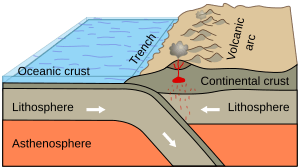Convergent boundary facts for kids
A convergent plate boundary is a place on Earth where two of the planet's huge plates of rock, called tectonic plates, push into each other. This collision can involve two oceanic plates, two continental plates, or one of each. When these massive plates collide, it causes very powerful movements in the Earth.
These collisions can lead to many geological events, such as earthquakes, volcanoes, and the formation of huge mountain ranges. A famous example is the Himalayas, the world's highest mountain range, which was formed when the Indian plate crashed into the Eurasian plate. Earthquakes and volcanoes are very common near these boundaries. This is because of the immense pressure, friction, and the melting of rock material deep inside the Earth's mantle.
Contents
How Plates Collide
When tectonic plates meet at a convergent boundary, different things can happen depending on the type of plates involved.
Oceanic-Continental Collision
When an oceanic plate and a continental plate collide, the thinner, denser oceanic plate usually slides underneath the thicker, lighter continental plate. This process is called subduction.
- Oceanic crust moves under: As the oceanic plate goes down, it creates a deep ditch in the ocean floor called an oceanic trench. These trenches are often found near the coast.
- Volcanoes form: As the oceanic plate sinks deeper into the Earth's hot mantle, it starts to melt. This melted rock, called magma, rises to the surface and forms a chain of volcanoes inland, often in an arc shape. You can see this along the western edge of the Americas, where the Pacific plate is subducting under the North and South American plates.
Continental-Continental Collision
When two continental plates collide, neither plate is easily pushed under the other because they are both relatively light and thick. Instead, the crust crumples and folds upwards.
- Mountains form: The edges of the continental plates fold and break, creating enormous mountain ranges.
- High plateaus: Behind these mountains, a high, flat area called a plateau can form. The Himalayas and the Tibetan Plateau are a perfect example of this type of collision. The Indian plate crashed into the Eurasian plate, pushing up the Himalayas and the vast Tibetan Plateau behind them.
See also
 In Spanish: Borde convergente para niños
In Spanish: Borde convergente para niños




